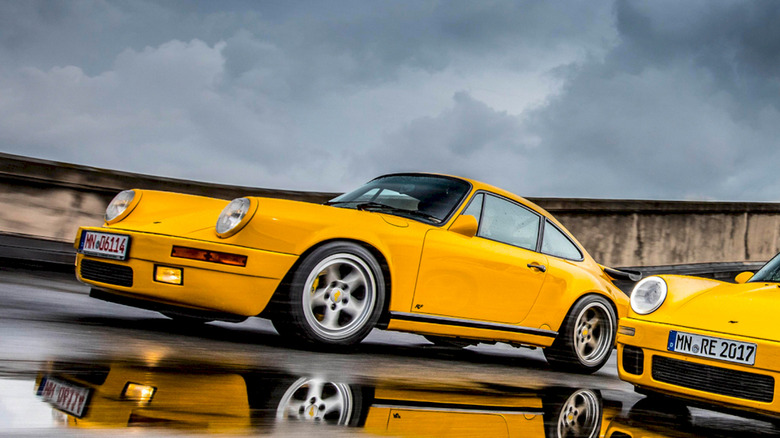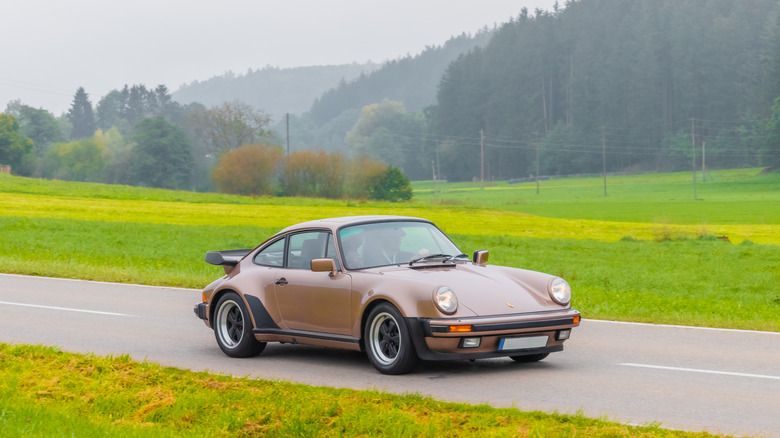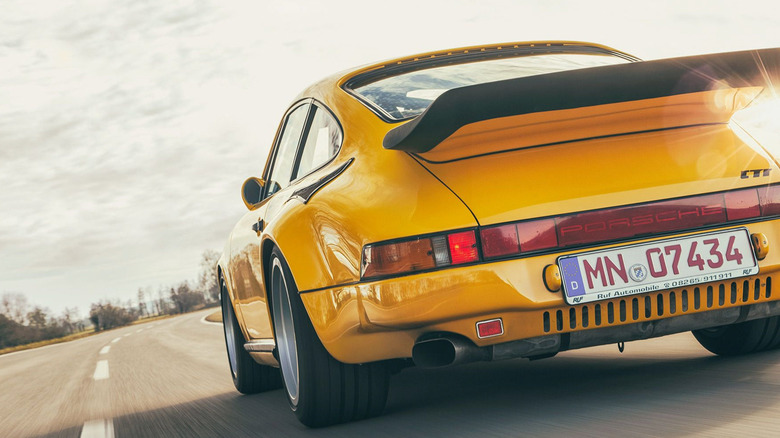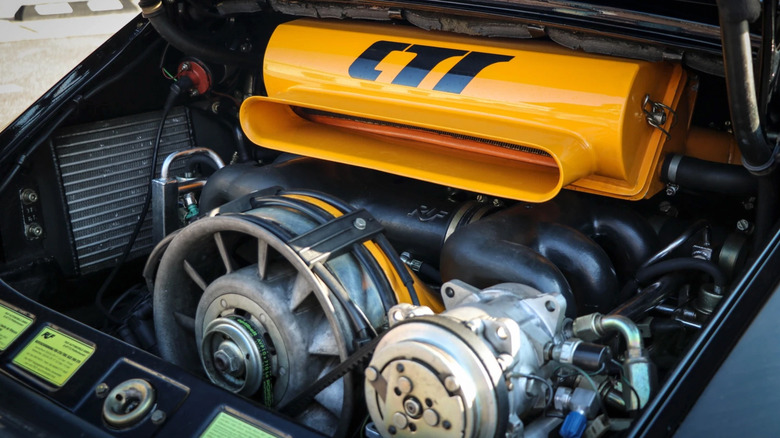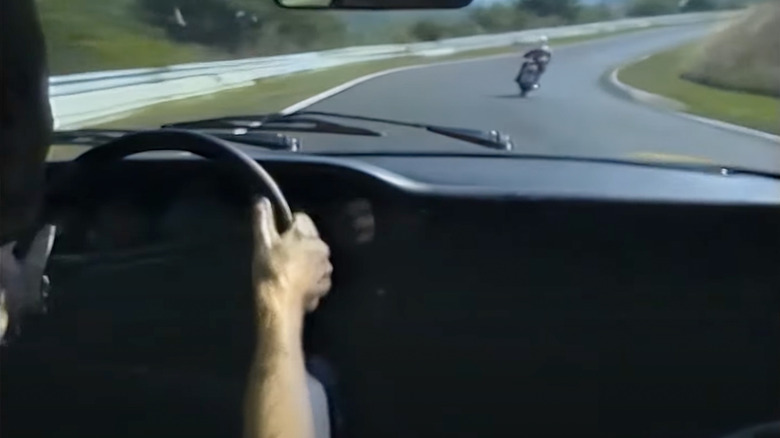The Ruf CTR Was Way Cooler Than You Remember
Not all Porsche 911s are the same. Some 911s aren't even technically Porsches. For example, the car that looks like a 911 you see here is actually called the Ruf CTR and is better known by its nickname, the Yellowbird.
Before we get to the car itself, on the left of the above image, a quick history lesson: Ruf (pronounced 'roof') is a family-owned car manufacturer based in Bavaria, Germany. It was founded in 1939 by Alois Ruf and started out making buses. His son Alois Jr later joined the business and expanded it to one that serviced and restored Porsche cars. By the mid-seventies, Alois Jr had assumed control of the company and began modifying Porsches. Ruf's first own-badged car, called the 911 SCR, arrived in 1978, and the model name is still used today.
The company produces a range of its own sports cars, as well as selling uprated components to improve the performance of contemporary Porsches like the 992-generation 911. You may also recognize the Ruf name from old video games like Gran Turismo 2, where its cars appeared instead of those from Porsche.
For many sports car fans, it was the CTR from 1987 that firmly put Ruf on the map, thanks to its 211 mph top speed. It was crowned "the fastest production car in the world" by Road & Track magazine that same year.
A car manufacturer in its own right
In the late 1970s and early 1980s, Porsche considered retiring the iconic 911 and replacing it with the 928. But, partly thanks to rave reviews of the 911-based Ruf SCR in the motoring press, a renewed enthusiasm for the 911 convinced Porsche to keep it.
It was also around this time, in 1981, that Ruf was no longer merely a car tuner but was re-designated under German law as a manufacturer. It was then able to fit its own VIN plates to chassis provided by Porsche.
Next came the Ruf BTR, which began life as a Porsche 930, pictured above, before having its engine capacity increased to 3.4 liters. It produced 369 horsepower, sprinted to 60 mph in 4.3 seconds, passed 100 mph in under 10 seconds, and had a top speed of 190 mph. It was offered with wide and narrow body styles and featured upgrades like performance suspension, Recaro seats with racing harnesses, and an uprated exhaust. A 1985 BTR sold at auction in 2022 for $445,000 was described by RM Sotheby's as "the ultimate evolution of Ruf's early expertise; a peerless example of extreme analog performance."
The Yellowbird takes flight
Launched in 1987, the Ruf CTR (or Group C Turbo Ruf) is powered by a 3.4-liter, flat-six engine with separate turbos and intercoolers for each cylinder bank, plus a pressure-sensitive electronic control system from Bosch. As well as packing more power than a standard 911 — to the tune of 469 horsepower and 408 lb-ft of torque — the CTR had reinforced chassis joints and suspension mounting points, plus a hood, fenders, and doors made from lightweight aluminum.
The modified interior featured Recaro seats and a roll cage. The cabin was described in 2013 by Car and Driver as an "old-school 911 with a stripped-back-RS-style twist." The magazine added: "Like all air-cooled 911s, it feels narrow and upright, and the floor-hinged pedals are a little awkward."
Ruf claimed the CTR weighed 2,579 pounds, giving it a better power-to-weight ratio than a 2014 911 Turbo S. Writing about the CTR at the time, Road & Track said: "The Ruf Yellowbird is almost frighteningly fast, with an unbelievable ability to keep accelerating through the gears like a rocket leaving the launch pad. And the sounds! Anyone who ever dreamed of being a race driver will find this a symphony of mechanical perfection."
The magazine added: "In our acceleration testing at Hockenheim race circuit, the RUF Yellowbird zipped from 0-60 mph in a mere 4.0 seconds and flew through the quarter-mile traps in 11.7 sec at 133.5 mph. That, my friends, is what one may call blindingly quick."
The world's fastest car
In 1987, Road & Track pitted the CTR against contemporary supercars like the Ferrari 288 GTO, Porsche 959 and Lamborghini Countach. The result was a win for the Ruf, which clocked 209 mph at Volkswagen's Ehra-Lessien test track. The magazine said of the CTR: "At each gear shift the Ruf went slightly sideways, only to straighten for an explosive burst of speed to the next gear, more like what I imagined a top-fuel dragster to be than a perfectly drivable road car."
A year later, the magazine's 1988 World's Fastest Cars edition saw the CTR go even faster, reaching 211 mph and setting a new street car speed record.
Priced at $177,000 with the exchange rate of the day, the Ruf CTR was described as "an incredible piece of work for the money," with the magazine concluding: "There are other cars that will cost you just as much or more, but try to find one that is faster. By our reckoning, it can't be done."
Despite the Yellowbird nickname, the CTR was also available in colors other than canary yellow. A black example sold at auction in 2018 for $1,022,500. In total, 30 examples of the CTR were built.
Faszination on the Nürburgring
Known for producing the world's fastest car seemingly wasn't enough for Ruf, so in 1989, it produced a publicity video. The destination was the Nürburging, and while that sounds obvious today, three decades ago, the German circuit was almost unheard of.
Speaking to TopGear about the video in 2023, Alois Ruf Jr said: "Because most company presentations are so boring...nobody watches them. And they have this horrible music. So we decided to make some really dynamic shots from the 'Ring. We're driving around, we have a helicopter, a cameraman, and while we were there, Stefan [Roser, the CTR's driver] said, 'Maybe there are some people that would be crazy enough to see a full lap. Why don't we make a full lap for them?'".
The result is a grainy, 20-minute video called Faszination on the Nürburgring featuring a Yellowbird CTR driven on the ragged edge for two laps, engine blaring, and tires smoking at almost every corner. Although quiet compared to today's public sessions, the track was open to others, and the Ruf is seen power-sliding its way past a couple of motorbikes in the screen grab above.
As marketing videos go, it's right up there with a loafer-wearing Ayrton Senna lapping Suzuka in a Honda NSX and surely cements the Yellowbird's reputation as one of the fastest — and coolest — supercars of all time.
